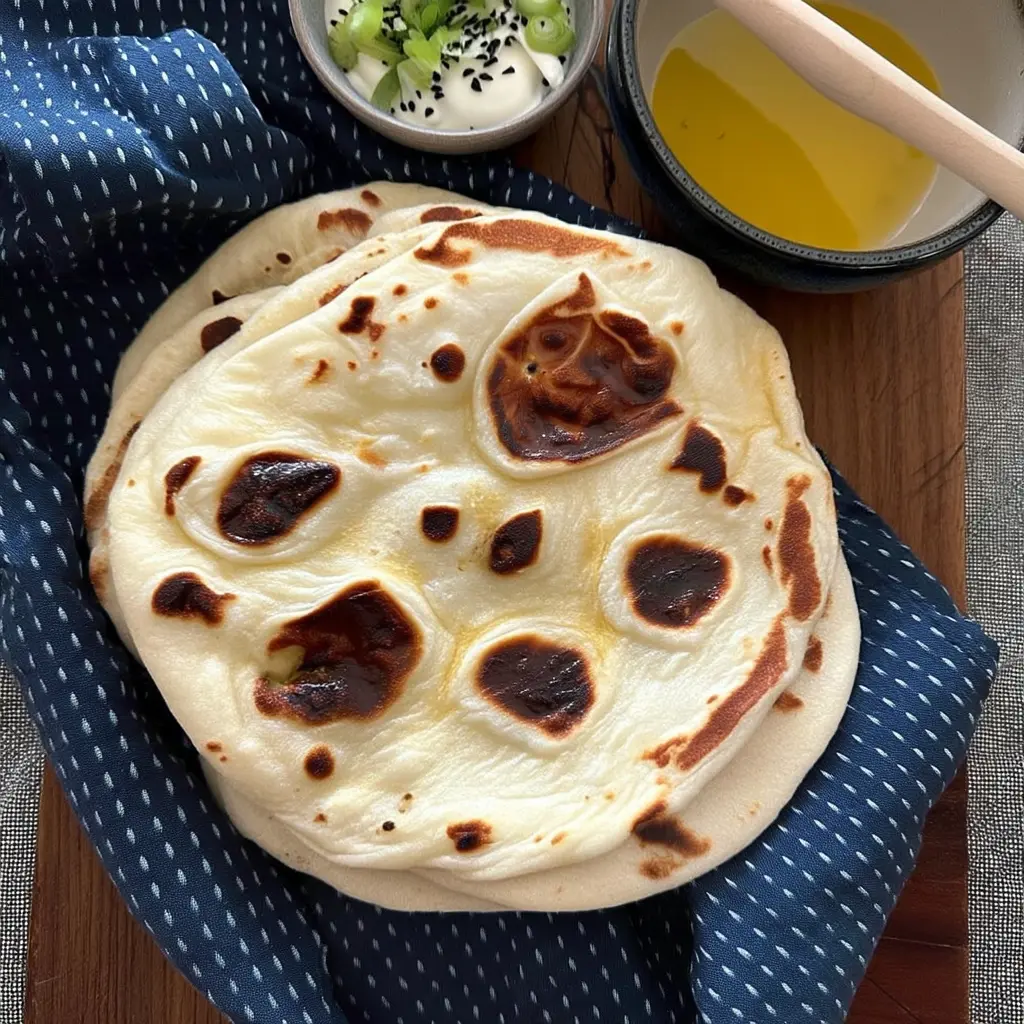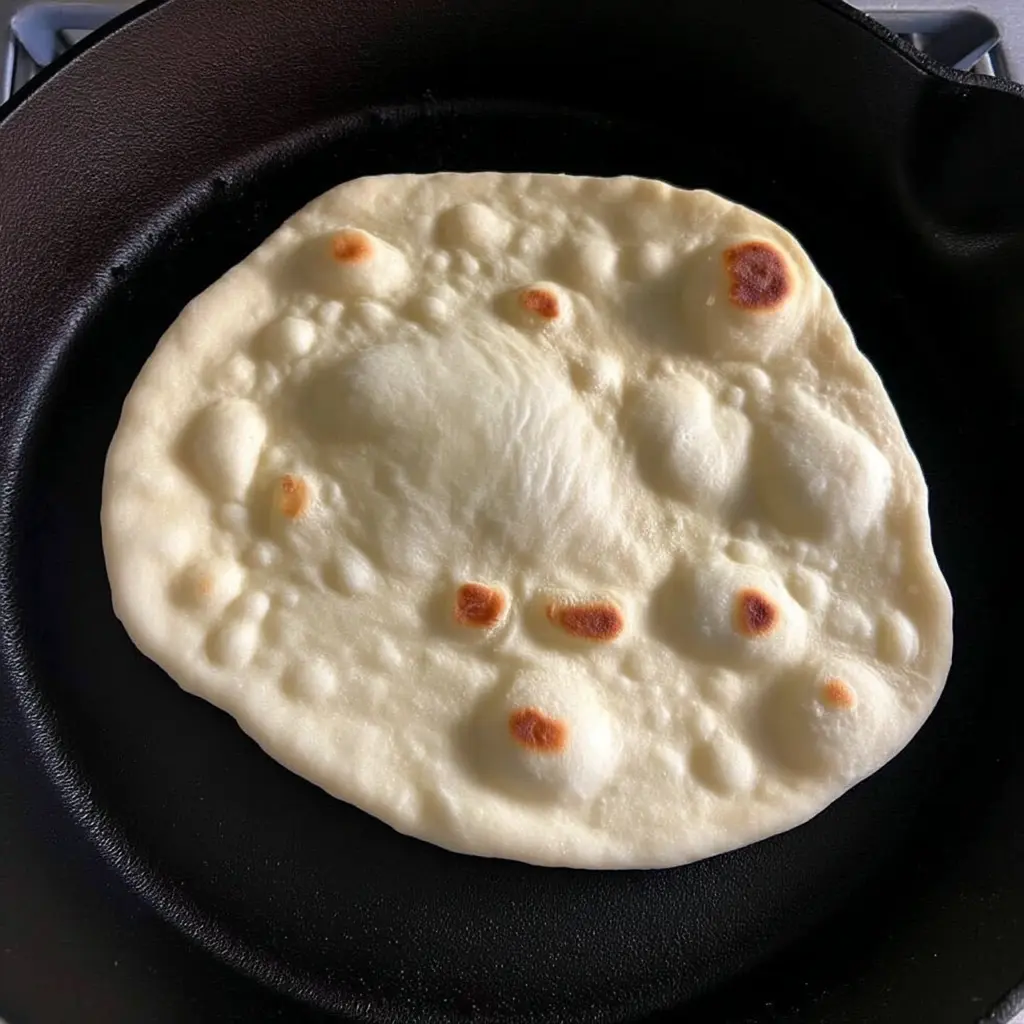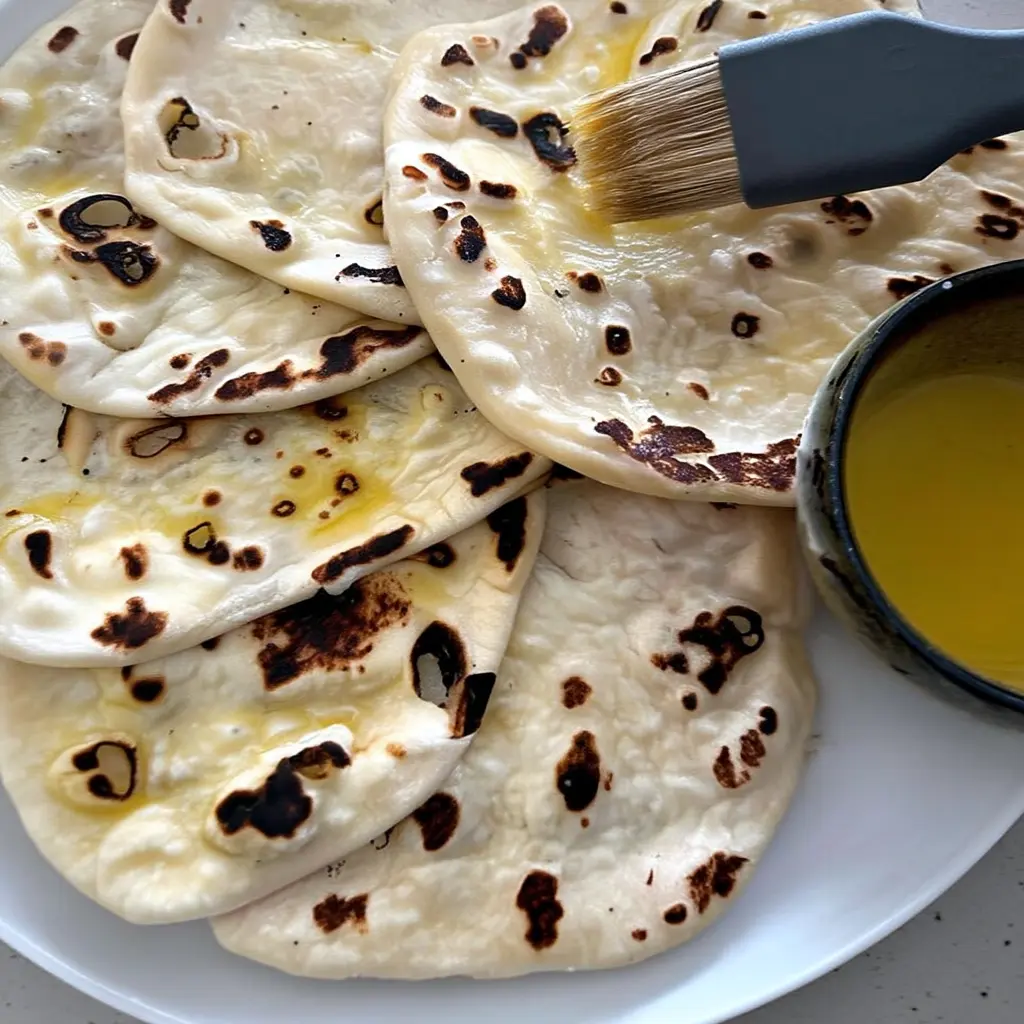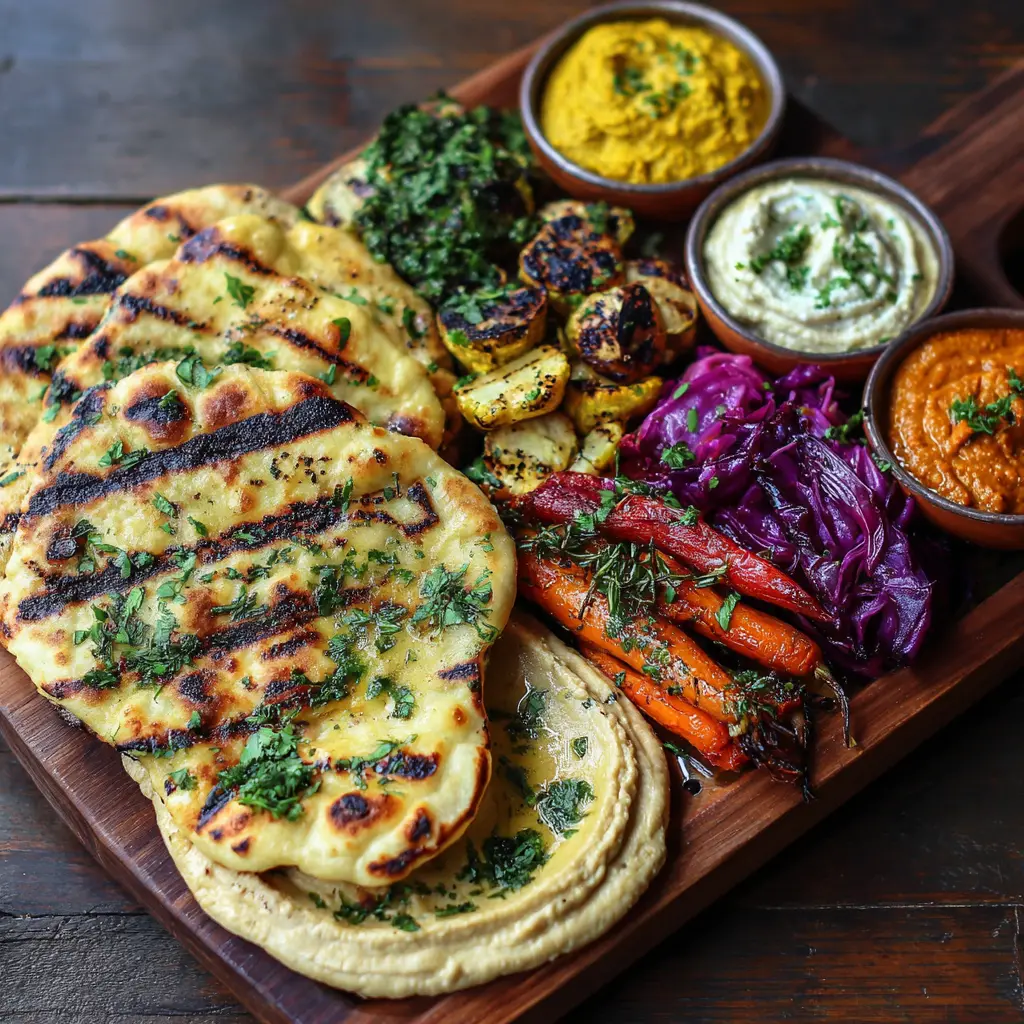Sourdough Naan isn’t just another flatbread—it’s a flavor journey, and here at DishRCP, we’re all about transforming everyday baking into extraordinary experiences.
It started with a bubbling jar of sourdough starter on our kitchen counter—a little wild, a little unpredictable, and bursting with potential. At DishRCP, we challenged ourselves to give this humble staple a bold new identity. The result? A soft, chewy, tangy naan that brings together the heritage of sourdough and the soul of Indian comfort food.
No yeast. No fancy tools. Just real, honest ingredients like warm milk, creamy Greek yogurt, olive oil, and that signature tang from our sourdough starter or discard. Our community loved the texture. They raved about the flavor. And now, we’re giving you the complete breakdown—from ingredients and technique to tips for a flawless cook every time.
This article is more than just a recipe—it’s a full guide for home cooks who crave flavor, texture, and something a little special. So grab your mixing bowl, fire up that skillet, and let’s roll.
Table of Contents
Table of Contents

Understanding Sourdough Naan and Its Unique Appeal
What is Sourdough Naan?
Sourdough naan is a type of flatbread that’s traditionally cooked on a hot skillet or tandoor. Unlike regular naan which uses commercial yeast or baking powder alone, this version includes a natural sourdough starter or discard—a fermented mix of flour and water. This not only helps the dough rise but adds complex tangy notes and a softer, chewier texture.
Why Use Sourdough in Naan?
Using a sourdough starter in naan serves several purposes:
- Flavor Boost: Adds depth, sourness, and a subtle richness.
- Digestibility: Sourdough fermentation breaks down gluten, making the bread easier on the stomach.
- No Commercial Yeast Needed: Perfect for anyone avoiding commercial yeast.
Sourdough Naan vs. Traditional Naan
| Feature | Traditional Naan | Sourdough Naan |
|---|---|---|
| Leavening Agent | Yeast or baking powder | Sourdough starter/discard |
| Flavor | Mild and slightly sweet | Tangy, rich, and complex |
| Time to Prepare | Faster (1-2 hours) | Longer (due to fermentation) |
| Texture | Fluffy and airy | Fluffy with more chewiness |
| Shelf Life | Shorter | Longer (natural preservation) |
The Health Benefits of Sourdough Naan
In addition to flavor and texture, sourdough naan offers real health perks:
- Lower Glycemic Index: Great for managing blood sugar.
- Gut Health Support: Thanks to natural fermentation.
- Increased Nutrient Absorption: Phytic acid is broken down during fermentation, making nutrients more bioavailable.
Best Occasions to Serve It
Whether you’re prepping a weeknight curry or impressing guests at a summer BBQ, sourdough naan pairs beautifully with:
- Chicken tikka masala
- Butter paneer
- Hummus and Mediterranean platters
- Garlic herb dips
Fore more recipes follow my pinterest
Print
Sourdough Naan
- Total Time: 45 minutes
- Yield: 12 naan breads 1x
Description
Soft, tender, and full of flavor, this sourdough naan bread is made with a tangy sourdough starter and creamy yogurt. Cooked on a hot griddle, it’s the perfect companion for your favorite curry or stew.
Ingredients
- 120 g Milk warm
- 125 g Greek Yogurt
- 150 g Sourdough Starter or sourdough discard (see notes)
- 20 g Olive Oil
- 400 g All Purpose Flour
- 12 g Baking Powder
- 10 g Salt
Instructions
Step-by-Step Instructions for Sourdough Naan
Mix Wet Ingredients:
In a large bowl, combine the warm milk, Greek yogurt, olive oil, and sourdough starter. Whisk gently until smooth.Form the Dough:
Add the flour, baking powder, and salt to the bowl. Mix everything together until a shaggy, slightly dry dough forms. Cover the bowl with plastic wrap and let it rest for 30 minutes.Initial Knead:
After resting, knead the dough in the bowl until it becomes smoother and slightly elastic. Cover again and let it rest for another 30 minutes.Final Knead on Counter:
Turn the dough out onto a clean counter. Knead vigorously until soft and elastic. The dough should feel slightly sticky but not cling to your hands. Avoid adding extra flour.Bulk Fermentation:
Place the kneaded dough back into a bowl and cover with plastic wrap. Let it ferment in a warm spot until doubled in size.Divide & Shape:
Once risen, divide the dough into 12 equal pieces. Using a kitchen scale helps ensure uniform size—68g each if you want naan like the photos. Roll each piece into a ball and let them rest for 30 minutes.Roll Out the Naan:
Flatten each ball with your fingertips into a rough oval or round shape. You can use a rolling pin or simply stretch the dough by hand.Cook the Naan:
Heat a cast iron skillet or fry pan until it’s searing hot. Do not grease the pan. Lightly spray or brush each naan with water before placing it wet-side down into the skillet.Flip & Finish:
Cook for 20–30 seconds until bubbles form, then flip and cook the other side for another 20–30 seconds. The naan should puff up with golden brown spots.Brush with Butter:
Remove from the skillet and immediately brush each naan with melted butter.Repeat:
Continue until all naan breads are cooked and brushed.
Notes
Sourdough Starter Tips
For best results, use an active, bubbly sourdough starter. It helps the dough rise well and gives your naan a balanced flavor. If you’re using sourdough discard, expect a longer bulk fermentation time and a tangier flavor, especially since the yogurt also adds acidity. Because this recipe doesn’t include added yeast, only use discard if your starter is at least 2–4 weeks old and reliably doubles in size.
Kneading Notes
This dough is easy to knead by hand. You can also use a stand mixer or Thermomix. Knead for about 3 to 6 minutes until the dough is smooth and elastic.
Bulk Fermentation Tips
While you can use discard, an active starter is preferred for better fermentation. Keep your dough in a warm spot to rise efficiently. A warm environment will help speed things up.
Cooking Notes
Sourdough naan cooks best on a cast iron skillet, which gives you that perfect char and puff. A stainless steel pan also works if needed. You can also grill them on a hot BBQ or grill plate for excellent results.
- Prep Time: 30minutes
- Cook Time: 15minutes
- Category: Baking, Side Dish, Sides
- Cuisine: American
Nutrition
- Serving Size: 12 Naan Breads
- Calories: 162 kcal
- Sugar: 1g
- Sodium: 438mg
- Fat: 3g
- Saturated Fat: 1g
- Unsaturated Fat: 1g
- Trans Fat: 0.3g
- Carbohydrates: 29g
- Fiber: 1g
- Protein: 5g
- Cholesterol: 2mg
Ingredients Breakdown for Perfect Sourdough Naan
The Essential Role of Each Ingredient
Every ingredient in your sourdough naan plays a crucial part in texture, taste, and rise. Understanding why each one matters helps you make substitutions or adjustments when needed—without compromising the outcome.
Milk (120g – Warm)
Milk adds softness and moisture. Warm milk, in particular, helps activate the starter and aids in kneading. Don’t overheat it—just slightly warmer than body temperature is perfect.
Greek Yogurt (125g)
Greek yogurt provides fat, acidity, and body to the dough. It boosts tenderness and gives naan its signature richness. It also contributes to the tang when combined with the sourdough starter.
Sourdough Starter or Discard (150g)
This is the soul of the recipe. You can use:
- Active sourdough starter: Bubbly, lively, and ready to leaven. Results in quicker fermentation and a lighter flavor.
- Sourdough discard: A little older and more acidic, leading to a stronger sour flavor and slower fermentation.
Note: At DishRCP, we recommend using starter that reliably doubles in size within 4-6 hours for the best results.
Olive Oil (20g)
Olive oil makes the dough soft and pliable. It also helps keep naan tender after cooking.
All-Purpose Flour (400g)
We prefer unbleached all-purpose flour for this recipe—it offers the right gluten structure without toughness. You can sub with bread flour for extra chew or use a 50/50 mix with whole wheat for more fiber.
Baking Powder (12g)
Since the recipe lacks commercial yeast, baking powder provides a quick lift during cooking. It ensures puffiness on the skillet.
Salt (10g)
Essential for flavor and structure. Don’t skip or reduce it drastically—it balances the sourness and brings everything together.
Optional Add-ins for Custom Flavors
Want to level up your naan game? Here are some variations you can try:
- Chopped Garlic: Add to dough or brush over after cooking
- Chopped Cilantro: For herbaceous flair
- Nigella or Cumin Seeds: Sprinkle on top before cooking
- Butter or Ghee: Brush after skillet for that restaurant-style finish
Ingredient Substitutions: What Works and What Doesn’t
| Ingredient | Substitute Option | Notes |
|---|---|---|
| Milk | Oat or almond milk | Use warm, unsweetened versions for similar results |
| Greek Yogurt | Regular plain yogurt | Drain excess water if it’s too thin |
| Olive Oil | Melted butter, avocado oil | Changes flavor slightly |
| All-Purpose Flour | Bread flour or mix with wheat flour | Adjust hydration slightly |
| Sourdough Starter | Only discard if well-maintained | Fermentation will take longer |
Ingredient Quality Tips from DishRCP
- Always weigh ingredients for accuracy—this dough is hydration-sensitive.
- If using discard, plan for a longer rise time.
- Use filtered or non-chlorinated water in your starter to keep it active.

The Step-by-Step Process: Mixing, Resting & Fermenting Dough Like a Pro
Step 1: Combine the Wet Ingredients
Start with a large mixing bowl. Add the following:
- 120g warm milk
- 125g Greek yogurt
- 20g olive oil
- 150g sourdough starter or discard
Gently mix everything together using a balloon whisk or a dough whisk. The mixture should look creamy, slightly thick, and uniform.
Pro Tip from DishRCP: Make sure your sourdough starter is room temperature for best activation.
Step 2: Add the Dry Ingredients
Sprinkle in the dry ingredients:
- 400g all-purpose flour
- 12g baking powder
- 10g salt
Use your hands or a spoon to mix the dough until it becomes shaggy and dry. Don’t overmix here—you’re just combining.
Cover the bowl with plastic wrap or a damp towel and allow it to rest for 30 minutes. This rest helps the flour absorb moisture, making kneading much easier.
Step 3: Knead into Smooth Elastic Dough
After resting, knead the dough directly in the bowl or transfer it to a clean surface. You’ll notice it has become slightly smoother.
Knead until the dough becomes soft, elastic, and stretchy. It should feel slightly sticky but not stick to your hands.
| Kneading Method | Time Estimate | Notes |
|---|---|---|
| By hand | 6–10 minutes | Use folding and pushing motions |
| Stand mixer | 4–6 minutes | Use dough hook on low speed |
| Thermomix | 3–5 minutes | Set to knead function |
Avoid adding extra flour—this can toughen your naan.
Step 4: Bulk Fermentation
Place the kneaded dough in a lightly oiled bowl, cover it with plastic wrap, and set it in a warm spot.
Let the dough rest until doubled in size. Timing depends on your starter:
- Active starter: ~2–4 hours
- Discard: ~6–8 hours (may take longer in cool environments)
DishRCP Tip: Create a warm proofing box by turning on your oven light with the door closed.
Step 5: Divide and Pre-shape
Once the dough has doubled, gently deflate it and divide it into 12 equal pieces (or fewer if you want larger naan). At DishRCP, we shape each piece to about 68g for even cooking.
Shape each piece into a tight dough ball by tucking the edges underneath. Let the dough balls rest on a tray, covered with a towel, for another 30 minutes.
Step 6: Roll Out Each Naan
After resting, flatten each dough ball using:
- Your fingertips for a rustic look
- Rolling pin for smoother rounds or ovals
Stretch the dough gently without tearing. Each naan should be rolled out thin, but not so thin that it becomes see-through.
Cooking Sourdough Naan Like a Chef
Heat Matters: Skillet or Grill?
When it comes to cooking sourdough naan, heat is everything. You want a searing hot skillet or grill to mimic the traditional tandoor oven. We strongly recommend a cast iron skillet, which retains heat and distributes it evenly.
You can also use:
- A stainless steel fry pan
- A pizza stone (preheated in the oven)
- A gas grill or BBQ with a grill plate
No matter what, do not add oil to the pan. The dry surface is essential for proper bubble formation and that signature sourdough naan char.
Rolling and Shaping Tips for Authentic Texture
By now, your dough balls have rested and are ready to be shaped.
- Use your fingers to flatten the dough gently into an oval or round.
- Then, use a rolling pin to stretch it further to about ¼ inch thick.
- Don’t press too hard—you want air to remain in the dough.
Sourdough naan gets its softness from gentle handling and fermentation. Overworking the dough can ruin that fluffy texture.
Time to Cook: From Dough to Flatbread in 60 Seconds
Here’s the exact process DishRCP uses to get bubbly, blistered, tender naan every time:
- Preheat your skillet until it’s smoking hot (literally).
- Spray one side of the naan lightly with water—this creates steam and bubbles.
- Place the naan onto the hot pan with the wet side facing down.
- Cook for 20–30 seconds, or until large bubbles begin to form.
- Flip and cook the other side for another 20–30 seconds.
Repeat the process until each naan is golden, puffed, and beautifully blistered with dark charred spots.
Brush It with Butter (or Ghee)
Once your naan comes off the skillet, brush it immediately with melted butter or ghee. This adds flavor, prevents drying, and gives that glistening restaurant-style finish.
Try adding:
- Minced garlic and chopped parsley to the butter for garlic naan
- A pinch of sea salt and chili flakes for spicy naan
- Melted ghee and honey for a dessert-style naan
How to Keep Sourdough Naan Warm and Fresh
Stack the cooked naan in a clean kitchen towel or wrap them in foil to keep warm. This keeps them warm and soft.
To reheat:
- Skillet: 10 seconds on each side
- Microwave: 10–15 seconds with a damp paper towel
- Oven: 300°F for 5 minutes wrapped in foil
Pro Tips from DishRCP’s Test Kitchen
- Always cook on high heat—low temps result in dry, tough naan.
- Don’t walk away from the pan—sourdough naan cooks lightning-fast.
- If your naan isn’t forming bubbles, the skillet needs to be hotter.
With this step complete, you’re now fully equipped to make sourdough naan like a chef—from prep to plate. Next, we’ll explore Part 5: Storage, Reheating & Freezing Tips for Sourdough Naan to help you make batches ahead of time.
Storage, Reheating & Freezing Tips for Sourdough Naan
Can You Store Sourdough Naan? Absolutely.
One of the many perks of making sourdough naan is how well it stores. Thanks to the natural acidity from the starter, it resists staling longer than yeast-based bread.
Once fully cooled:
- Stack naan in an airtight container or resealable bag.
- Keep at room temperature for up to 2 days.
- For longer shelf life, refrigerate up to 5 days.
DishRCP Tip: Place parchment between each naan to prevent sticking.
Reheating: Restore the Fresh-Baked Softness
If your naan feels dry or stiff the next day, don’t worry—it just needs a little heat to bounce back.
Here are your best options for reheating sourdough naan:
| Method | Instructions | Texture Result |
|---|---|---|
| Skillet | Heat for 10–15 sec per side on medium heat | Slightly crisp edges |
| Oven | Wrap in foil, 300°F for 5 minutes | Soft all around |
| Microwave | 10–12 seconds with damp paper towel | Soft, quick, convenient |
Avoid the toaster, which can make naan dry and brittle.
Can You Freeze Sourdough Naan?
Absolutely—and sourdough naan freezes beautifully.
How to Freeze:
- Let naan cool completely.
- Stack with parchment between each piece.
- Transfer to a freezer bag and squeeze out the excess air.
- Label and freeze for up to 2 months.
How to Reheat Frozen Naan:
- No need to thaw: just warm directly in a skillet or oven.
- For best texture, mist with water before reheating.
Make-Ahead Tips for Meal Prep Wins
- Par-cook naan: Cook each side for 10 seconds and cool. Freeze partially cooked naan and finish cooking them later on a skillet.
- Batch cooking: Double the dough and store half uncooked in the freezer. Thaw overnight in the fridge before rolling out.
How to Tell When Naan Has Gone Bad
Discard your naan if:
- It smells sour or off (beyond natural tang).
- You see mold, especially if stored over 4–5 days.
- It feels overly hard and cracking, even after reheating.
With proper storage, your sourdough naan will stay soft, flavorful, and ready to accompany any meal—even on busy weeknights.

Creative Serving Ideas and Recipe Pairings for Sourdough Naan
Why Sourdough Naan is the Ultimate Sidekick
One of the things we love most at DishRCP is how versatile sourdough naan is. It’s not just a bread—it’s a base, a scoop, a wrap, and even a snack all on its own. Thanks to the tangy undertone from the sourdough, this naan elevates every bite it touches.
Whether you keep it classic or go gourmet, there are endless ways to enjoy sourdough naan.
Savory Serving Pairings: Dip, Scoop, Wrap
These ideas will turn your sourdough naan into the star of the plate:
1. Dips and Spreads
| Dip | Flavor Match Notes |
|---|---|
| Hummus | Creamy meets tangy |
| Roasted Red Pepper Dip | Smoky with a slight sweetness |
| Baba Ganoush | Earthy, silky, and a perfect naan partner |
| Tzatziki | Cooling yogurt balances naan’s tang |
2. Curries & Stews
- Butter chicken
- Chana masala
- Saag paneer
- Lamb rogan josh
The soft chew of sourdough naan makes it ideal for soaking up thick, spiced gravies.
3. Wrap Fillings
Use naan as a wrap for:
- Grilled chicken or lamb
- Falafel
- Halloumi and grilled veggies
- Shawarma
Add lettuce, pickles, tahini, and wrap it up for a handheld feast.
Sweet Ideas You Never Saw Coming
Yes, you read that right—sourdough naan goes sweet too.
- Brush with butter + cinnamon sugar for dessert naan
- Spread with Nutella or almond butter
- Add slices of banana or berries
- Drizzle with honey and sprinkle sea salt
Pair it with tea, coffee, or chilled milk for a light breakfast or snack.
Turn It Into a Pizza or Flatbread
Transform your naan into:
- Spread tomato sauce on naan, sprinkle with cheese, and add your favorite toppings.
- Breakfast flatbread: Add eggs, spinach, and feta
- Bruschetta base: Toasted naan with tomatoes and basil
Just bake at 400°F for 8–10 minutes until crisped to your liking.
Hosting Tip: Build a Naan Board
Create a DIY naan board with:
- Sourdough naan (cut in halves or quarters)
- A trio of dips (hummus, chutney, yogurt sauce)
- Fresh veggies and herbs
- Spiced nuts or olives
Your guests will rave—and your naan will disappear fast.
Common Mistakes to Avoid When Making Sourdough Naan
1. Using an Inactive or Weak Starter
Your sourdough naan needs a starter that’s active and bubbling to achieve the perfect rise and flavor. If your starter hasn’t been fed in days, or doesn’t double in volume within 4–6 hours, you’ll end up with:
- Dense, flat naan
- Overly sour flavor
- Inconsistent texture
DishRCP Tip: Feed your starter at least 4 hours before using. If using discard, allow more time to ferment.
2. Adding Extra Flour During Kneading
When the dough gets a little sticky, it’s tempting to throw in more flour. But extra flour makes the dough tough, and naan should be soft and stretchy.
Sourdough naan dough is supposed to feel:
- Slightly tacky, but not wet
- Elastic and easy to stretch
Lightly oil your hands instead of flouring them—that keeps the dough soft without stickiness.
3. Under- or Over-Fermenting
This is a huge one. If you rush fermentation, your naan won’t puff or have enough flavor. If you let it ferment too long, it could:
- Collapse
- Become overly sour
- Tear while shaping
| Starter Type | Bulk Fermentation Time |
|---|---|
| Active Starter | 2–4 hours |
| Sourdough Discard | 6–8 hours or overnight |
4. Skipping the Dough Ball Rest Time
After dividing your dough, you must let the dough balls rest for at least 30 minutes. This:
- Relaxes the gluten
- Makes rolling easier
- Prevents shrinking on the skillet
Skipping this step often results in misshapen or dense sourdough naan.
5. Pan Too Cool or Uneven Heat
Sourdough naan requires a blazing hot skillet. If your pan isn’t hot enough:
- You won’t get the iconic bubbles
- Naan will dry out before browning
- It may stick or tear when flipped
How to test skillet heat:
- Water droplets should sizzle and evaporate instantly
- A piece of dough should puff within 30 seconds
6. Overcooking or Burning the Naan
Because the skillet is so hot, you have to move fast. Overcooking turns naan dry or even bitter from burnt spots.
Cook each side for just 30–45 seconds max. As soon as the bubbles form and the bottom browns—flip!
7. Not Brushing with Butter or Ghee
This last step adds flavor and locks in moisture. Forgetting to brush your naan can lead to:
- Dry texture
- Flat flavor
- Less authentic feel
Brush each naan right after it comes off the heat, while it’s still hot and steamy.Common Mistakes to Avoid When Making Sourdough Naan
1. Using an Inactive or Weak Starter
Your sourdough naan needs a starter that’s active and bubbling to achieve the perfect rise and flavor. If your starter hasn’t been fed in days, or doesn’t double in volume within 4–6 hours, you’ll end up with:
- Dense, flat naan
- Overly sour flavor
- Inconsistent texture
DishRCP Tip: Feed your starter at least 4 hours before using. If using discard, allow more time to ferment.
2. Adding Extra Flour During Kneading
When the dough gets a little sticky, it’s tempting to throw in more flour. But extra flour makes the dough tough, and naan should be soft and stretchy.
Sourdough naan dough is supposed to feel:
- Slightly tacky, but not wet
- Elastic and easy to stretch
Lightly oil your hands instead of flouring them—that keeps the dough soft without stickiness.
3. Under- or Over-Fermenting
This is a huge one. If you rush fermentation, your naan won’t puff or have enough flavor. If you let it ferment too long, it could:
- Collapse
- Become overly sour
- Tear while shaping
| Starter Type | Bulk Fermentation Time |
|---|---|
| Active Starter | 2–4 hours |
| Sourdough Discard | 6–8 hours or overnight |
4. Skipping the Dough Ball Rest Time
After dividing your dough, you must let the dough balls rest for at least 30 minutes. This:
- Relaxes the gluten
- Makes rolling easier
- Prevents shrinking on the skillet
Skipping this step often results in misshapen or dense sourdough naan.
5. Pan Too Cool or Uneven Heat
Sourdough naan requires a blazing hot skillet. If your pan isn’t hot enough:
- You won’t get the iconic bubbles
- Naan will dry out before browning
- It may stick or tear when flipped
How to test skillet heat:
- Water droplets should sizzle and evaporate instantly
- The dough should puff up in about 30 seconds.
6. Overcooking or Burning the Naan
Because the skillet is so hot, you have to move fast. Overcooking turns naan dry or even bitter from burnt spots.
Cook each side for just 30–45 seconds max. As soon as the bubbles form and the bottom browns—flip!
7. Not Brushing with Butter or Ghee
This last step adds flavor and locks in moisture. Forgetting to brush your naan can lead to:
- Dry texture
- Flat flavor
- Less authentic feel
Brush each naan right after it comes off the heat, while it’s still hot and steamy.

Sourdough Naan for Special Diets (Vegan, Gluten-Free & More)
Adapting Sourdough Naan for Dietary Needs
At DishRCP, we believe everyone deserves to enjoy sourdough naan that’s both flavorful and fits their dietary needs. Whether you’re plant-based, gluten-sensitive, or cutting dairy, here’s how to tweak the classic recipe without losing flavor or texture.
Vegan Sourdough Naan (No Dairy, No Eggs)
The original recipe uses milk and Greek yogurt, but you can easily make it 100% vegan.
Simple Vegan Swaps:
| Ingredient | Vegan Alternative | Notes |
|---|---|---|
| Warm milk (120g) | Unsweetened oat or almond milk | Slightly nutty flavor, similar texture |
| Greek yogurt (125g) | Coconut yogurt or soy yogurt | Use plain, thick variety for best results |
| Butter (for brushing) | Olive oil or vegan butter | Adds rich finish and keeps naan soft |
Bonus Tip:
Add ½ teaspoon of lemon juice or apple cider vinegar to your plant-based yogurt to boost tang and mimic the acidity of Greek yogurt.
Dairy-Free Sourdough Naan
Just like the vegan version—simply replace the dairy with your favorite plant-based alternatives. You’ll still get all the tang and softness sourdough naan is known for.
Best combinations:
- Oat milk + almond yogurt
- Soy milk + coconut yogurt
Brush with olive oil or a garlic-infused vegan ghee for a flavorful finish.
Sourdough Naan with No Yogurt (PAA1)
Yes, you can make sourdough naan without yogurt. It won’t be quite as tangy, but it will still be soft and delicious.
How:
- Replace yogurt with equal parts plant-based milk and a splash of lemon juice to create a faux “buttermilk” effect.
- Let it sit 5 minutes before adding.
This method keeps the dough soft and tasty, even without using yogurt.
Sourdough Naan with No Rise (PAA4)
Short on time? You can still make sourdough naan with no rise, but expect a flatter, chewier texture. Here’s how:
- Use baking powder only and skip bulk fermentation
- Mix, rest for 30 minutes, and cook immediately
It’s perfect for last-minute meals, though the flavor won’t be as deep as traditional fermented dough.
Gluten-Free Sourdough Naan: Does It Work?
Sourdough naan without gluten is possible, but it takes more work. You’ll need:
- A strong gluten-free sourdough starter (made with rice or sorghum flour)
- A blend of GF flours (like rice, buckwheat, and tapioca)
- Use xanthan gum or psyllium husk to replicate the dough’s stretch and structure.
Note: Gluten-free naan will be more delicate and won’t bubble like traditional naan, but it’s still delicious.
Conclusion: Master the Art of Sourdough Naan with DishRCP
From its tangy flavor and chewy texture to its endless serving possibilities, sourdough naan is the kind of recipe that keeps on giving. At DishRCP, we’ve perfected a method that works whether you’re using bubbly starter or discard, dairy or dairy-free options, and even gluten-free flours.
Once you’ve tried it, you’ll never want to go back to store-bought flatbread again. We encourage you to experiment, customize, and most importantly—enjoy every bite.
FAQs About Sourdough Naan
Can I make sourdough naan without yogurt?
Yes, absolutely. If you’re out of yogurt or avoiding dairy, replace it with plant-based milk mixed with lemon juice or vinegar. This creates a “sour” component that mimics yogurt’s acidity. Let the mixture sit for 5–10 minutes before adding to the dough. The naan will still be soft and slightly tangy.
What are the best sourdough naan recipes for beginners?
For beginners, use recipes that include active starter, baking powder, and simple ingredients like milk and yogurt. This article from DishRCP offers a well-balanced, foolproof version. If you’re in a hurry, our no-rise variation in Part 8 works great, too. Always start with all-purpose flour—it’s the most forgiving.
Can I use sourdough starter directly for naan?
Yes! You can use either active sourdough starter or discard. Active starter is ideal for quicker fermentation and a more mild flavor. Discard gives a stronger sour taste and takes longer to ferment. Just make sure your discard comes from a mature starter (at least 2 weeks old).
Can I skip the rise for sourdough naan?
Yes, but expect less puffiness and deeper flavor. For no-rise naan, use baking powder only and skip fermentation. Let the dough rest 30–60 minutes before rolling and cooking. This method is great when you’re short on time.
Why didn’t my sourdough naan puff up?
There are a few likely reasons:
Skillet wasn’t hot enough
Dough didn’t ferment long enough
Overworked or under-kneaded dough
Rolled too thin
For best puffing, cook on a searing hot cast iron skillet, and make sure your dough is well-rested and hydrated.
Can I freeze sourdough naan after cooking?
Definitely. Let naan cool completely, stack with parchment between pieces, and freeze in an airtight bag for up to 2 months. Reheat from frozen in a skillet or oven. You can also par-cook and freeze for faster reheating later.
